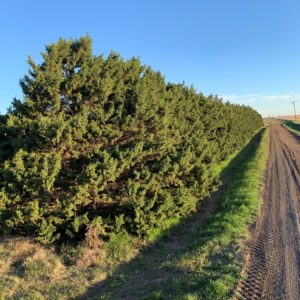Texas High Plains landowners can benefit from vegetative fuel breaks
Funds available for breaks providing time for residents, firefighters to evacuate
Texas A&M Forest Service is now accepting grant applications from landowners in the High Plains region of Texas who construct vegetative fuel breaks on their property.
The Vegetative Fuel Break Grant applications are open through Jan. 4 and could result in reimbursement to eligible recipients of up to $2,500 for the cost of trees, weed barriers, planting contractors, drip irrigation systems and other items associated with creating vegetative fuel breaks.
“This grant is intended to help protect communities in the High Plains by reducing the risks of catastrophic wildfire events on both public and private lands,” said Jake Gosschalk, wildland urban interface specialist with the Texas A&M Forest Service. “If landowners apply for this grant and create vegetative fuel breaks on their property, they will be more prepared for fire season.”
Fuel breaks, requirements
Green vegetative fuel breaks are trees and shrubs that are systematically planted adjacent to fields, homesteads or feedlots as a barrier to reduce or redirect the wind. Maintained fuel breaks can impact wind-driven fire behavior, allowing time for residents or firefighters to evacuate before the fire impacts nearby homes or structures.
For example, during the 2017 fire season, a well-maintained and irrigated vegetative fuel break or homestead windbreak impacted wind-driven fire behavior and provided time for residents to evacuate.
Fuel break projects eligible for the grant funds will need to consist of three rows of trees minimum and span at least 400 feet in length.
“Texas A&M Forest Service representatives are happy to answer any questions landowners have regarding the application process or how a vegetative fuel break can mitigate the risk of property damage caused by wildfires,” said Gosschalk.
All grant applicants will be notified of a decision by Jan. 31.
The Texas A&M Forest Service does not complete the actual planting and building of the vegetative fuel break but will conduct an on-site assessment of the landowner’s property prior to the approval of an application. If an application is approved, Texas A&M Forest Service will then further discuss the project details with the recipient.
Interested landowners may visit Communities in Action for a copy of the application. Application packages must be mailed to the following address:
Texas A&M Forest Service,
Mitigation & Prevention Department,
6330 Hwy. 290 E Suite 115,
Austin, TX 78723.



